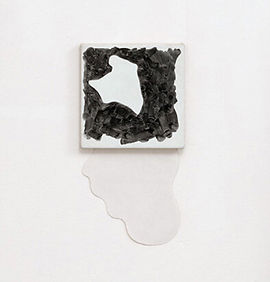Avis Newman

Configuration of no-thing, 2007-09
Acrylic paint and chalk on linen and cotton duck canvas, paper and 2 metal supports, 8 part work
Installation dimensions variable
Avis Newman’s practice spans painting and sculpture incorporating works on canvas, paper, and objects, but it is her approach to drawing and the conceptual space of drawing that I feel is of direct influence on my work.
She utilises the activity of drawing as a space of open-ended potential that allows for ‘uncertainty, paradox, contradiction, in a way that [she] didn’t find in the activity of painting…a very interesting space of excavation.’ (Maureen Paley, 2021) and it is in this way that she treats drawing as a ‘springboard’ (Maureen Paley, 2021) as an ‘operation for thought’ (Newman, 2021).
I especially enjoy how the poetics of the things she navigates are mirrored in her installations in a way that can be described as ‘different modalities of being’ (Newman, 2021). I like this idea a lot as I enjoy the scope of a works ability to be and do more than just one thing, a duality to be in/of more than one element, allowing for multiple levels of engagement.
Newman’s different modalities occur through a need to ‘exceed fixed boundaries and become provisional in nature. Here images do not suggest a correspondence to things in the world, but are things in themselves.’ (Newman, 2021). The very subjects she paints are unfixed with ‘layered references where meaning is not absolute’, things which are partially there on the brink of the tangible and nameable’ (Newman, 2021). This layering and interchangeable nature is carried through in a relational sense too. Her works are made up of ‘assemblages of interchangeable elements, layered, hung, and partially overlapped, which are arranged in sets or in sequences and that resist an absolute fixity’ (Newman, 2021). Newman’s understanding of installation chimes with my own ‘…to walk round something, to walk across something, to avoid something, to stand in front of something, to spend time with something, which is what we do with these objects, it’s always that state of recognition of our selves’ (Maureen Paley, 2021).
Here though, with no fixity, it makes for metaphorically slippery working conditions. You start working on a basis of rightness which Newman notes as ‘an internal thing to do with balance…it’s an emotional thing’ (Maureen Paley, 2021) that I resonate with, and I feel harks back to the activity of drawing too. The notion of balance then extends into the use of colour where, Newman says, it is not about the colour itself but more about the ‘weight and density and temperature’ things which are all felt. Here, the bodies of objects and paintings are talked about like the bodies of beings with a quote I find so fascinating, where Newman states that she ‘prefer[s] the silence of a physical body, rather than a visual body. It sounds paradoxical, but… that’s why most of my work is either very light or very dark’ (Maureen Paley, 2021).
The subject of bodies is carried forward once again in ‘showing the bones of what a painting is’ (Maureen Paley, 2021) the canvas is obvious, the seeped- through pigment shows its layers. Everything that materially makes up the work is almost raw, there is a sense of exposure. This awareness of exposure adds ‘another layer [to] the work… ‘what is the nature of making a painting?’, ‘what are we doing?’ (Maureen Paley, 2021). It allows for a continuous dialogue between the work itself and the very doing of the work. It becomes self-conscious and self-questioning thing.
There are limitations to Newman’s influence on my own works though, in that it retains its relation to painting very closely in a way that makes it too reserved, too quiet. Despite its mobile installation, it still relies almost solely on the wall, that picture plane and way of viewing doesn’t change much, and while I respect it, it isn’t mobile enough. And although I am very interested in Newman’s poetics and handling of the language she uses to describe and navigate her subject areas, for me, the language of her practice is too formal. There is a stiffness to it that drains the work of a personality that can play.
.jpg)
In Procession (detail) 2019. Dimensions not given

In Procession, 2019
Acrylic paint and chalk on canvas and paper, metal supports and pins, 14 part work
Installation dimensions variable


Aporia (Configurations) X 2010 (Series 1) 40 x 40cm
The blue is in the green, 2018
Acrylic paint on cotton canvas, canvas board, paper and metal, 13 part work: Installation dimensions variable

Configuration of no-thing II, 2006 - 2007
Acrylic paint on cotton and linen canvas, 3 part work: 1. 113cm x 124cm x 4cm, 2. 25cm x 30cm, 3. 25cm x 30cm
Newman, A (2021) Avis Newman. Available at: https://www.avisnewman.com (Accessed: 25 November 2021)
Maureen Paley (2021) MAUREEN PALEY. Avis Newman In Conversation. Available at: https://static1.squarespace.com/static/5bc705dbb2cf79dd7e03923b/t/6141e7a1e259206d62c667c5/1631709090370/Avis+Newman+in+conversation+with+Oliver+Evans+2021.pdf
(Accessed 7 January 2021)
Maureen Paley (2021) Avis Newman. Available at: https://www.maureenpaley.com/artists/avis-newman (Accessed 7 January 2021)